The boats
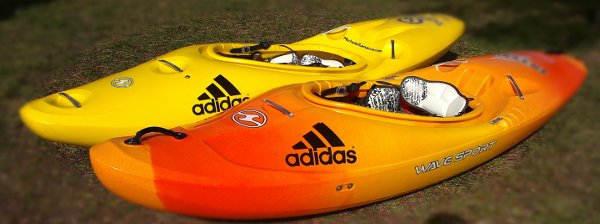
| Length: | 8'3" | 251 cm |
| Width: | 26.5" | 67 cm |
| Deck Height: | 15.25" | 39 cm |
| Weight: | 50 lbs | 23 kg |
| Cockpit Length: | 34" | 86 cm |
| Cockpit Width: | 19.25" | 49 cm |
| Volume: | 83 gal | 314 L |
| Length: | 8' 4" | 254 cm |
| Width: | 25.5" | 65 cm |
| Deck Height: | 15" | 38 cm |
| Weight: | 50 lbs. | 23 kg |
| Cockpit Length: | 33.5" | 85 cm |
| Cockpit Width: | 19" | 48 cm |
| Volume: | 80 gal | 303 L |
The tester
I'm an advanced paddler who love to race and teach kayaking to beginner and intermediate. I have good flatwater skills and a good slalom background.
I'm 76 kg for 183 cm.
Feelings
Before any test it's a good thing to talk about the different feelings those two boats give to the paddler.
I think the Recon, even if I have paddled the Habitat quite a lot, has given me immediately only good feelings in terms of:
- improved stability even with the weight on the back
- easy to maneuver, the bow is more responsive to the strokes
- very simple to boof and much softer to lift the nose moving the body forward and back
From an advanced paddler point of view these features help a lot when running hard drops and difficult whitewater. Racing with an easier boat can only give more chances not to fuck up!
From a beginner point of view it's also a very good help: things get easier and the progression is quicker.
Differences
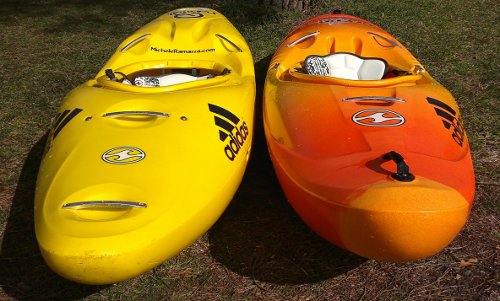
One of the first big difference is the bow. The Recon has a very high nose comparing to the Habitat. This feature has the aim to make the boof easier and to avoid water on the kayak while passing throught waves.
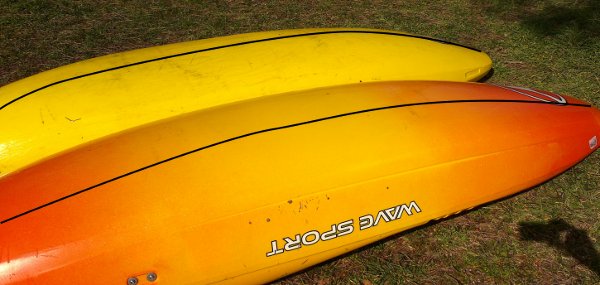
The Recon has a continuous rocker from the nose to the tail. This makes easier to lift the nose when is necessary.
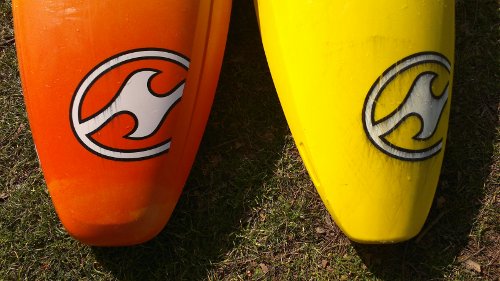
Recon's tail is wider and flatter. This feature gives more control and tends to make easier to keep a line into an eddy or during a ferry. The Recon should also be faster and more gliding when landing from boofs into a hole.
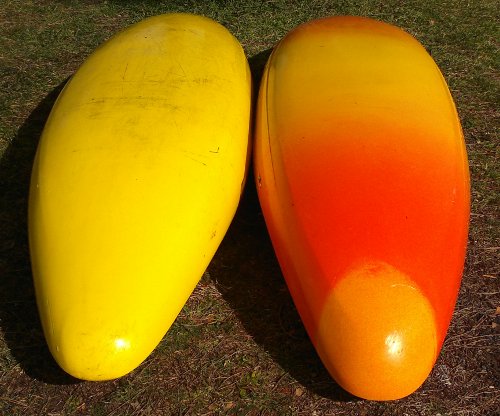
Recon's hull is flatter and wider especially in the seat area in order to improve stability. Its sides are very easy to lift, but when you lean too much you can feel a better secondary stability.
Flatwater test
The only fear I had was about linear speed and rotation. I was worried that all these good improvement in terms of usability would affect the performance of the boat.
For that reason I runned 2 tests in flatwater to verify this doubt.
Linear Speed test
The liner speed test was about a 25 m stretch in flatwater runned at maximum speed.
Over 4 times with each boat, switching one after the other, I noticed no valuable differences between the two boats. The time was always around 11.9 sec with the same variability of 0.1 sec (due to the normal time measurement mistake and paddler normal variability).
Figure 8 test
This test consists in a 10 m far gates to be run making a '8 line'. The result is expressed in meters per 1 minute. This test involves about 8 '180 degrees' rotations.
Over 4 times with each boat, switching one after the other, I have found again no valuable differences between the two boats. The distance was always around 81m.
Conclusion
The boats have pretty much the same performance in flatwater while the Recon has better skills because is easier to maneuver. I still haven't done proper test in steep creeks and drops but the feelings are clear: the Habitat had the problem to be hard to control in big volume while the Recon feels very responsive in big water.
The Recon is probably a bit heavier than the Habitat but with some modifications to the outfitting it's possible to make it about the same weight. I recommend the Recon 83 from 65 to 85 kg. The other models (70 and 93 gallons) will fit better lighter and heavier paddlers.
I think that the Recon is going to be appreciated a lot during the next 5-6 years!


